Introduction
The Tour was a post-conference tour for 5 days, departing Kiama on Saturday 17 September 2022 and finishing on the evening of Wednesday 21 September.
Sydney has the distinction and the fortune of being a major metropolis which is virtually surrounded by major national parks enabling residents and visitors to enjoy the natural environment without long distances to travel.
These include Australia’s oldest, and world’s second oldest national park and a World Heritage Area. And not only is the natural environment close by, it is a special area of biodiversity. The Sydney Sandstone flora is particularly diverse with many hundreds of species in a relatively small geographic area. In spring it can be a riot of colour with many species at peak flowering.
The aim of the tour was to introduce participants to these wonderful sandstone areas but also to visit and learn about the different ecological communities which exist within the Sydney area, including the Cumberland Plain of the western suburbs and to visit some special gardens. It was also planned that the walks involved would be shorter and less arduous than those on many tours.
The tour was organised by Merle Thompson OAM. In planning the itinerary she received assistance from Heather Miles, Sue Fredrickson, Wendy Grimm and members of the Parramatta-Hills, North Shore and Northern Beaches Groups. Additionally they and Jim Ward, were involved in compiling plant lists for locations visited. Sue was the tour leader and Wendy the botanical adviser. Participants found their leadership and information to be exceptionally good.
This report was written by Sue Fredrickson with additional comments from tour members and compiled by Merle Thompson.
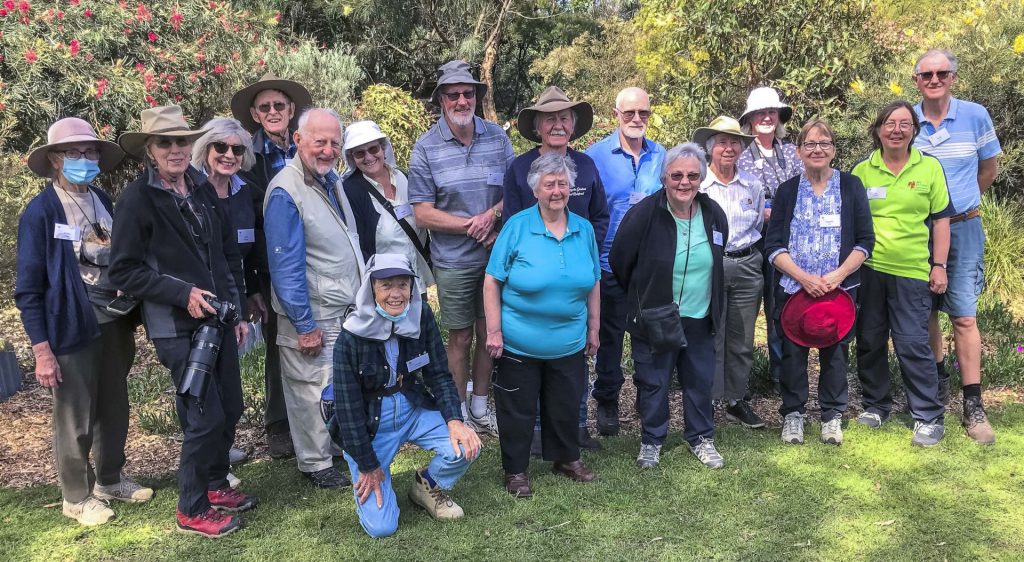
The tour experience
The tour called “Surprising Sydney Sandstone” lived up to its name!
The 16 participants from ACT, Tasmania, South Australia, Queensland, Victoria and 3 “locals” from NSW were all pleasantly surprised at the floral diversity and lovely scenery that our tour offered. They were all very positive about the floral diversity and beauty of plants and scenery.
We were treated to lovely displays of flowering plants – the late September timing of the visit and the fine weather which followed rainy months combined to put on a great flowering show.
Day 1
This took us past the green rolling hills of the Illawarra. We were able to see what we had driven past ie Lake Illawarra, Port Kembla and Wollongong from our first stop at Mt Keira Lookout with its panoramic views of the coastal plain. We also got our bearings from the Sublime Point Lookout further to the north and with views of the beautiful string of beaches north of Wollongong and also with views to the north and the distant Royal National Park that we would soon be visiting.
After one last panoramic view to the south from the Lawrence Hargrave Lookout, we were soon entering the Royal National Park. We drove along the entire length of the “Royal” with two stops at Wattamolla Beach and Bungoona Lookout at the Park’s Northern end.
The variety of largely geologically determined plant associations on the drive through the park was clearly visible as we passed Rainforest, Shale Gully Eucalypt Forests and Shale Ridge Forests followed by Sandstone Forest, Woodland and Heath as the geology changed half way up the park.
Wattamolla
By our lunch stop and walk at Wattamolla we were well and truly in Sandstone territory.
This was where we stopped and had lunch. The arrow in this pic is pointing to a rock from which location we heard the call of a very rare frog. Wendy was able to identify this fellow.
Bungoona Lookout walk
Bungoona Lookout walk is located in tree shaded low forest and so featured quite different flowering plants.
The lookout at the end of the track where one member said “Look at this and we are only 20 km from Sydney
Day 2
We went from our centrally located hotel in Parramatta to explore Western and North Western Sydney with the guiding being provided by members of APS Parramatta-Hills Group.
Boongala Native Gardens at Kenthurst was the first place we visited. Mal and Jenny Johnstone have developed the magnificent and colourful gardens over the decades.
Mal took us on a Bush Tucker and Rainforest Walk, all the time giving us excellent commentary on what he had set out to achieve with all the plantings. We could see that he had certainly succeeded!
Jones Road Fire Trail
Next nearby stop was a bushwalk in sandstone bush at Jones Rd Kenthurst. It did not disappoint with many plants flowering including the big drifts of Boronia.
The first two photos are of Mal and Boongala Garden by Sue Fredrickson and Phillip Grim. The last pic is lesley Waite a local group member with a drift of boronias at Jones Road Fire Trail.
Ian Cox’s Garden
Lunch was at our host Ian Cox’s lovely nearby property. He and Tamara, who is sadly no longer with us, developed a great native garden and shady comfortable lunching place sheltered amongst the ferns. Ian guided people around the garden. Sue’s photo captures Ian with the group having lunch amid Ian’s ferns. Followed by Merle’s shots of the garden.
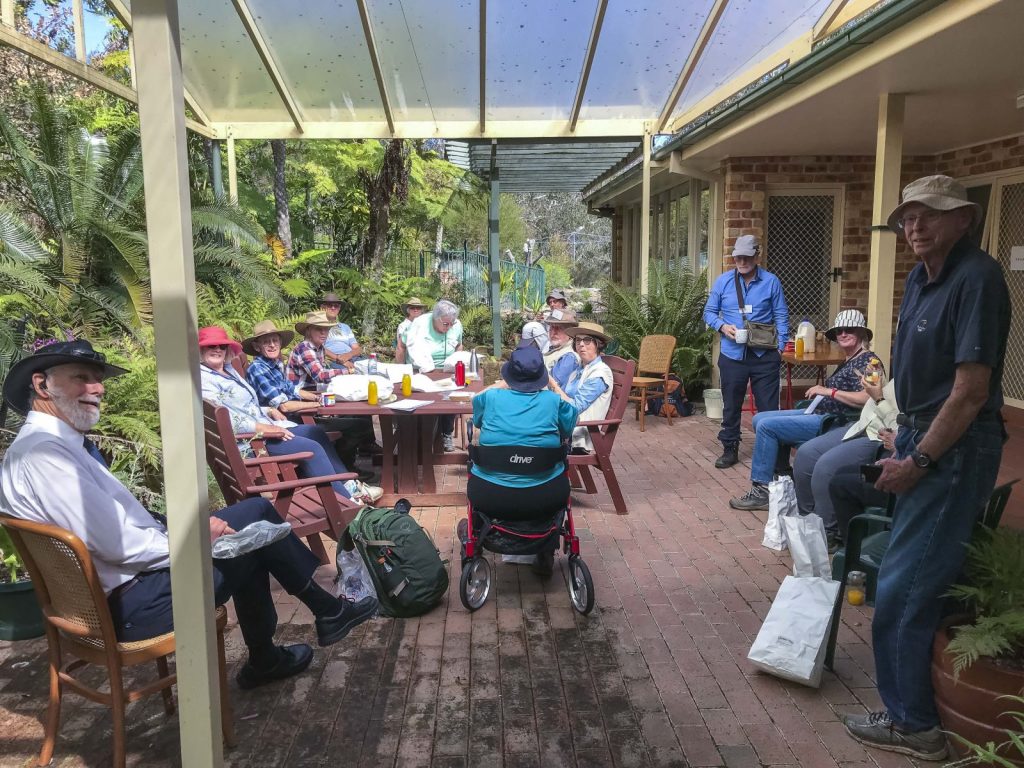
Windsor Downs Nature Reserve
Our final destination in Western Sydney was to Windsor Downs, a rare remnant of Cumberland Plain Woodland on Wianamatta Shale and Riverine Gravels protected in a Nature Reserve. Its variety of Vegetation associations with largely tall forest Eucalypts including Ironbarks, provide a stark contrast to the Sandstone vegetation to be experienced over the coming days of the tour.
Sue and Phillip’s photos show Jennifer Farrer, Parramatta-Hills member who, along with Pip Gibian introduced the group to the woodland flora of western Sydney.
Shirley took special interest in this trunk of Eucalyptus racemosa, showing why it is known as a “scribbly gum” and with a mud nest.
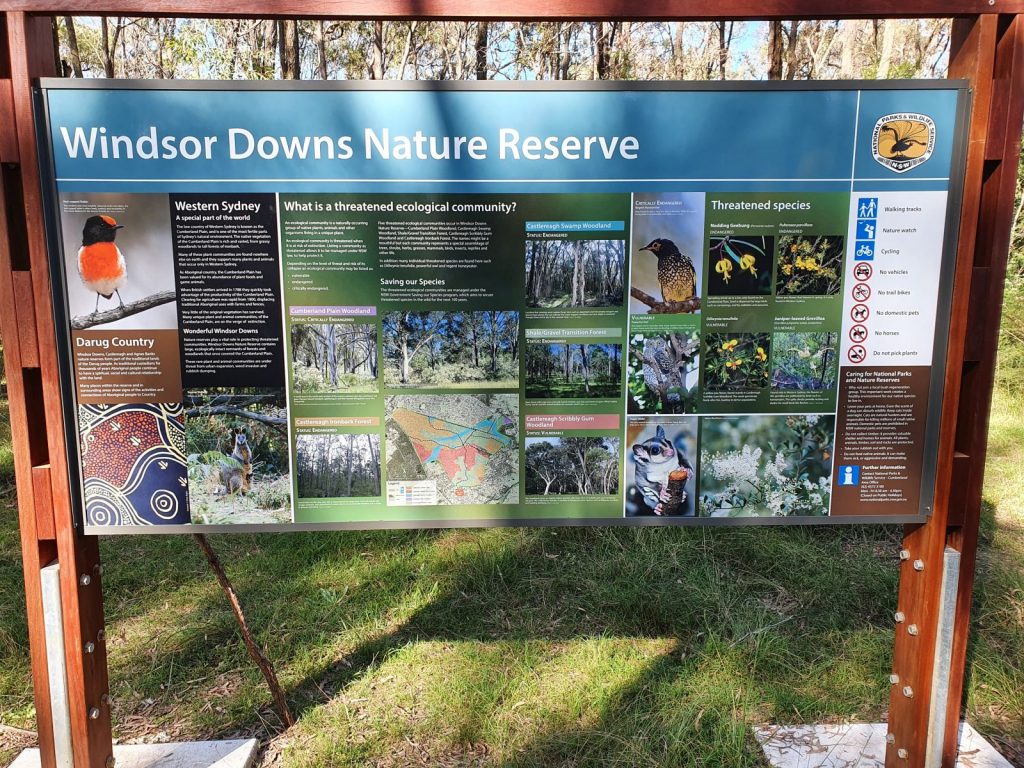
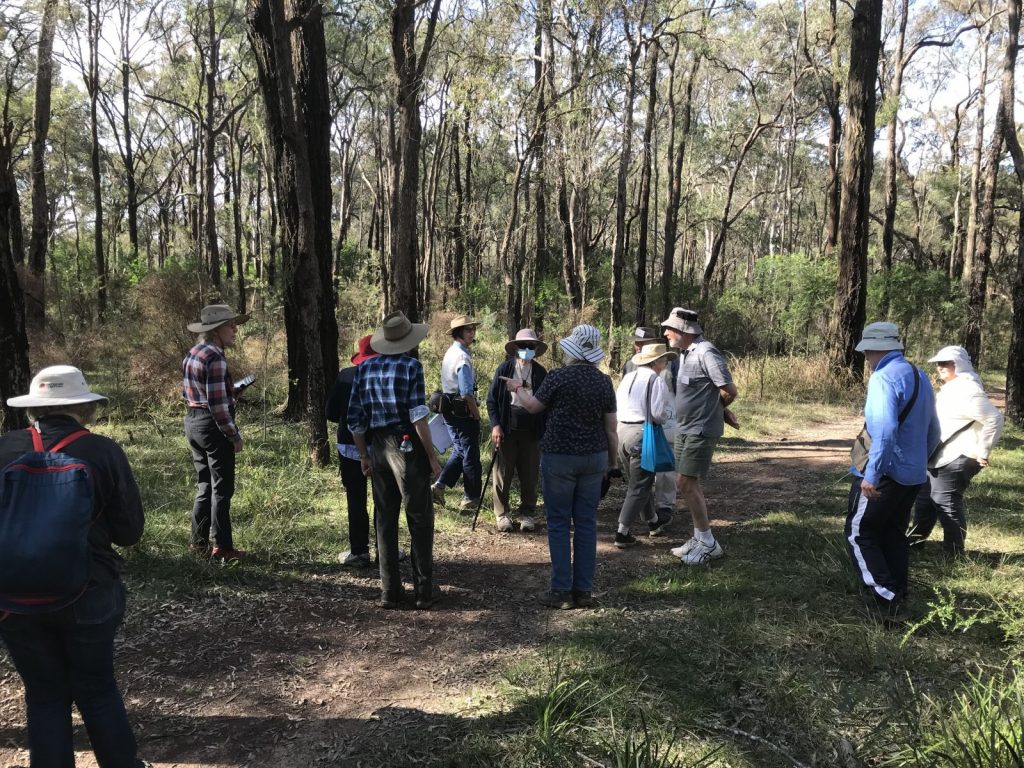
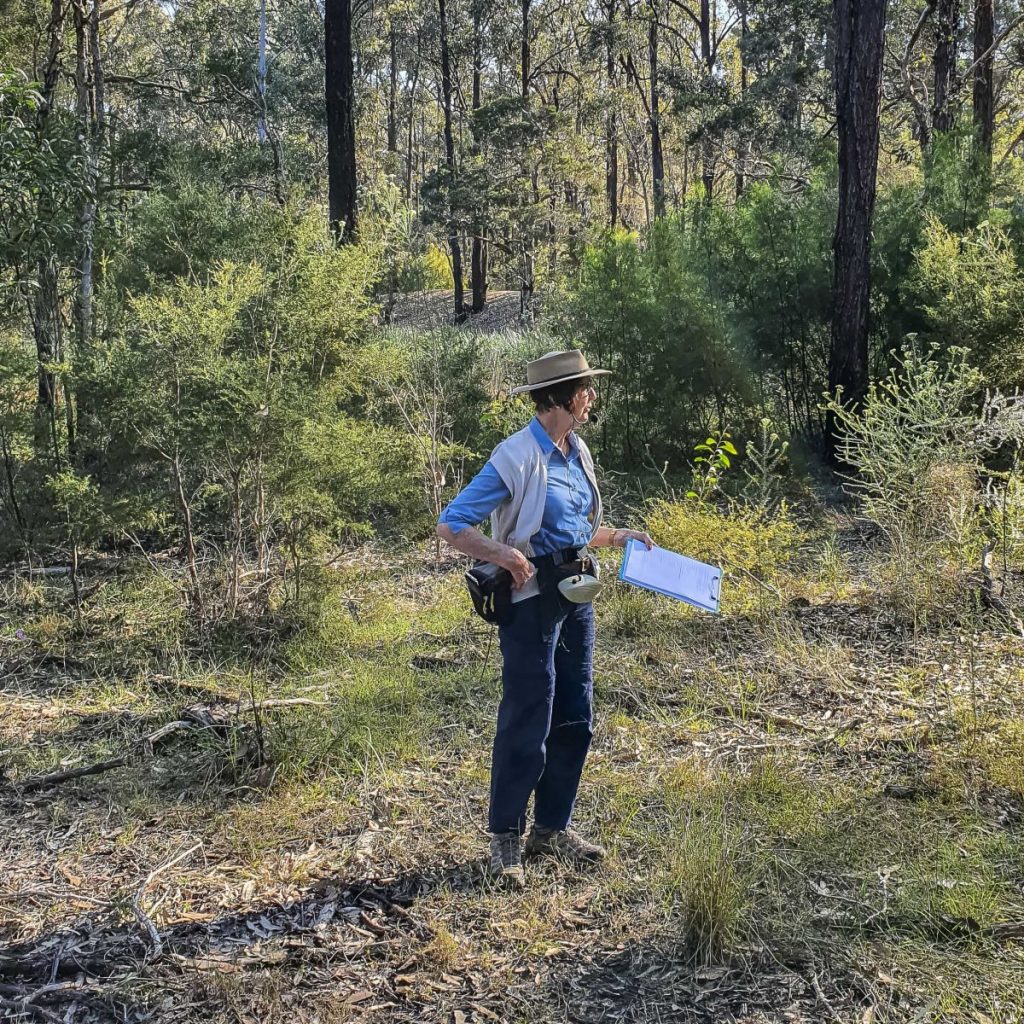
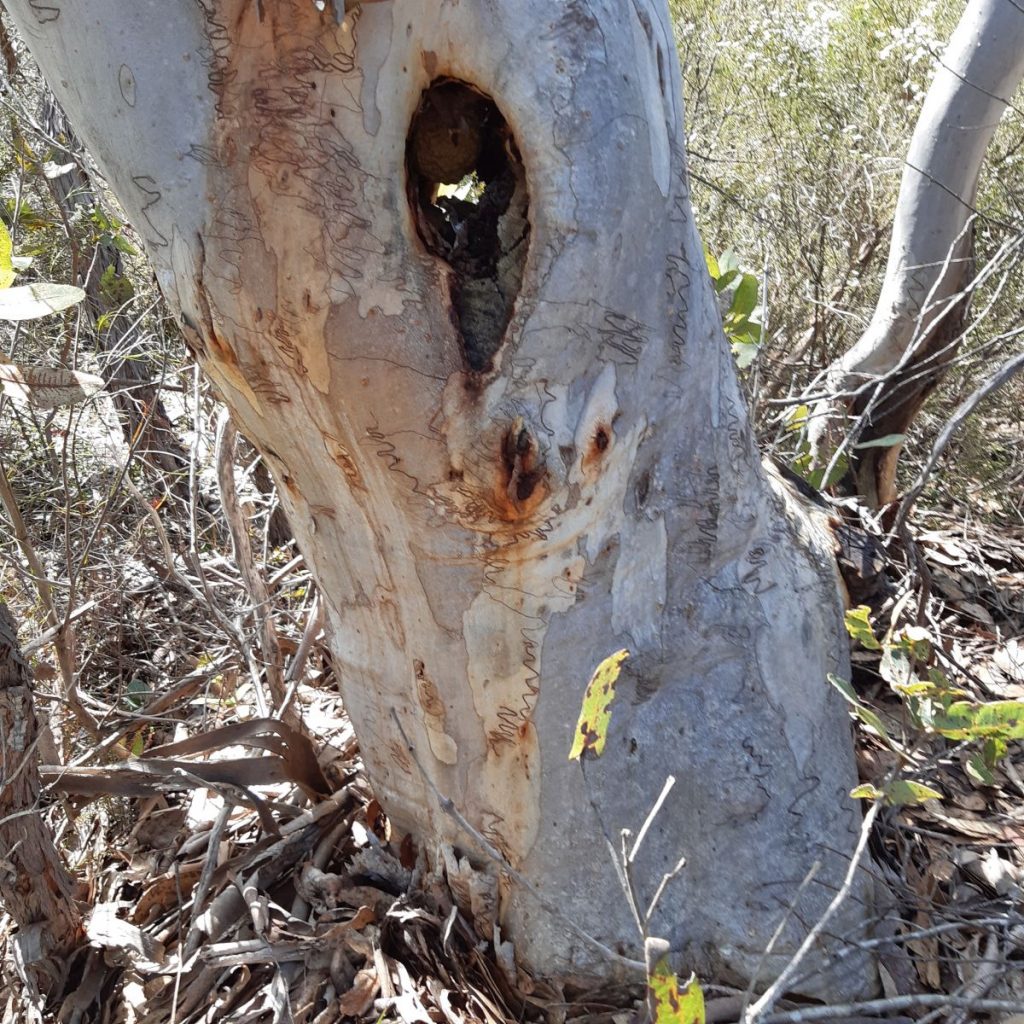
Day 3 Our day in Sydney city – Royal Botanic Gardens
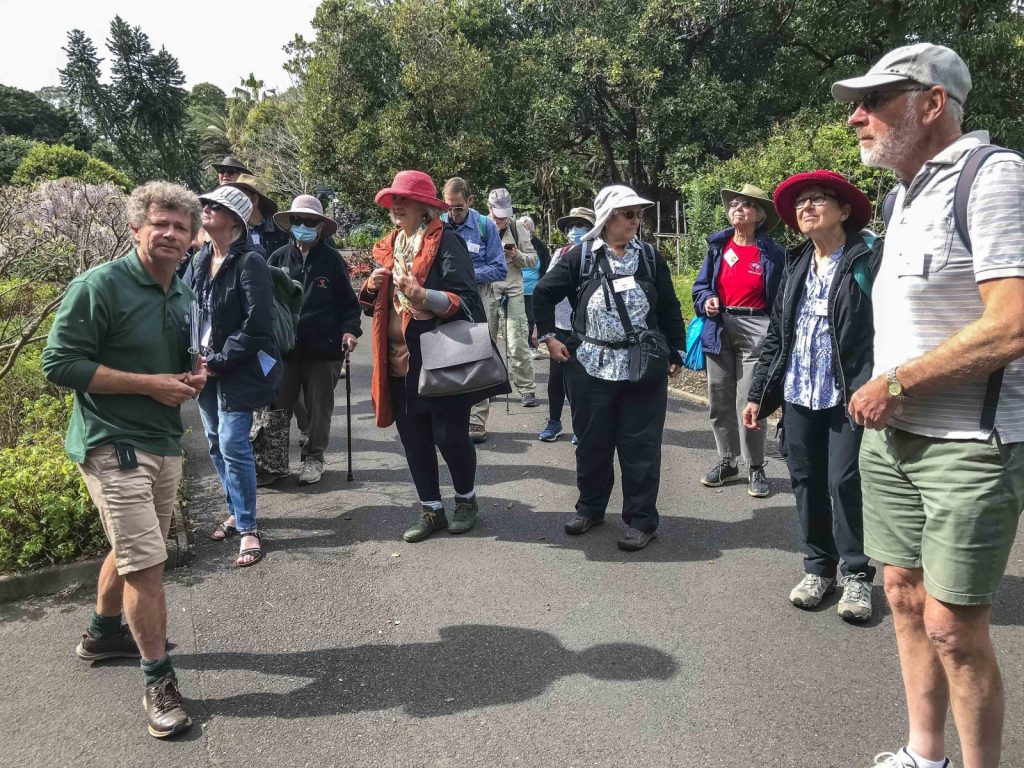
We were lucky enough to have very experienced guide Paul Nicholson for our visit to the Sydney Botanic Gardens. After a preliminary walk including the Cadi Jam Ora First Aboriginal Encounters and First Farm area,
Paul took us “behind the scenes” to the Nursery area and Orchid House, a rare opportunity! Paul has been on the horticultural staff of the Gardens and is Manager of the Volunteers Program. He is enthusiastic and entertaining as well as knowledgeable and provided a wonderful tour.
We were also taken to see the work in progress on the next major exhibition at “The Calyx”. We had the privilege to be the first to do so. It has a theme of diversity and will be a special feature during the Sydney WorldPride festival next year.
Paul led us through the Rainforest Plant exhibit area with many interesting species.
One of special interest to Merle was Eidothea hardeniana, a rare plant from northern NSW which was featured recently in the ABC’s program on favourite Australian trees. The species was named in honour of Gwen Harden, a member of APS NSW and the editor of the major work The Flora of NSW.
Right: Janelle’s photo
Below: Phillip’s showing Paul introducing the group to the plants in this special area.
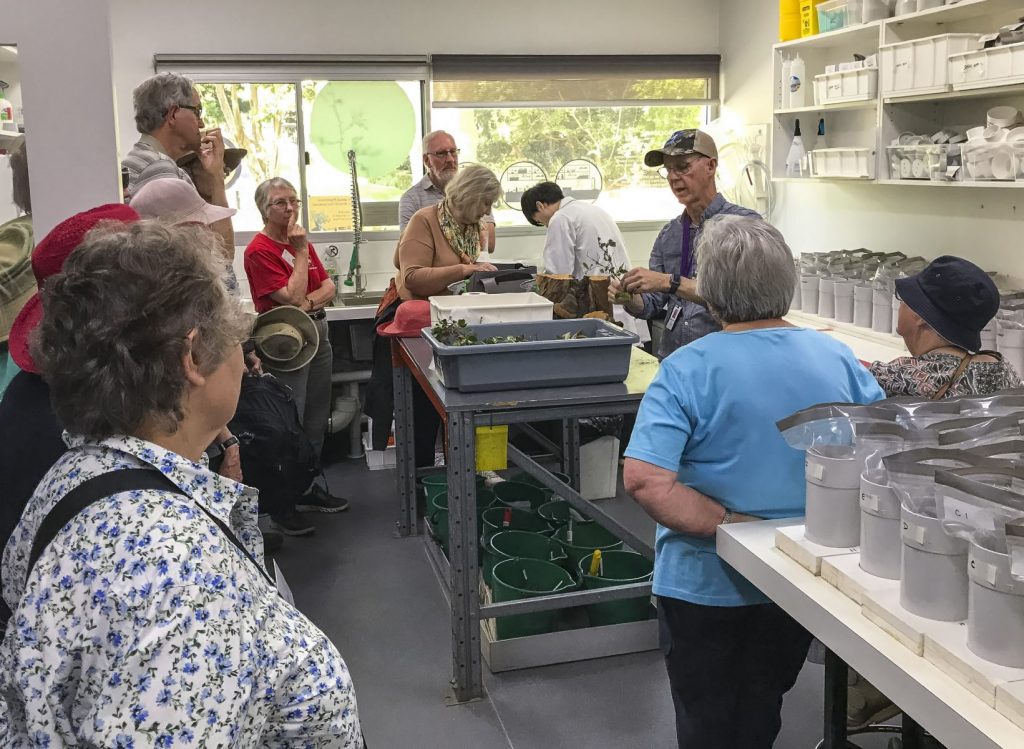
After enjoying lunch in a scenic part of the Gardens, with views nearby across to the Harbour Bridge and Opera House, our last visit in the Botanic Gardens was to the Plant Clinic.
At the Plant Clinic we were met by Chief Scientist and Director of Research, Brett Summerell. Brett explained to us some of the work that the Staff do at the Plant Clinic to identify and research specimens sent in by government agencies and commercial organisations as well as the public to be identified as potentially carrying such plant pathogens as Myrtle Rust and Phytopthera cinnamoni. Photo by Sue.
The importance of the work was highlighted when Brett was called away by a message that the Minister needed him.
Barangaroo Reserve
The rest of the day was spent wandering over Barangaroo Reserve. People marvelled at the work that has been done there to convert the old wharf area into an attractive native plant reserve adjacent to the scenic part of Sydney Harbour. On returning to the bus, our ever-helpful driver Michael had set up our afternoon tea in a sheltered place with views of the Harbour Bridge and harbour.
We were then driven to our second accommodation place at Terrey Hills, where we were to stay for 2 nights. Both accommodation venues, the Nesuto Hotel at Parramatta and Checkers Resort in Terrey Hills were great choices by Merle. They were comfortable, had friendly helpful staff, served generous dinners and breakfasts and prepared great lunches for us to take out daily on the road.
Day 4
The group was hosted by the North Shore Group ie with mostly Sue and Wendy, botanist extraordinaire, as guides.
The Centre Track, Terrey Hills
To quote Wendy: ”The Centre Track amble displayed a good variety of colourful Sydney sandstone heath flowers including the lovely Boronia serrulata or Native Rose” as shown below.
The Basin Track
On to a walk along the Basin Track with more heathland flowers and also the Aboriginal Rock Carvings. Below is Sue’s photo of the group surveying the rock carvings.
Some of the plants along the track, by Merle Thompson
West Head
Lunch was enjoyed at West Head with a backdrop of the spectacular scenery across to Palm Beach, the Hawkesbury River entrance and Lion Island and the Central Coast to the north. The sunny day added to the beauty which Merle, Lynne and Shirley all captured.
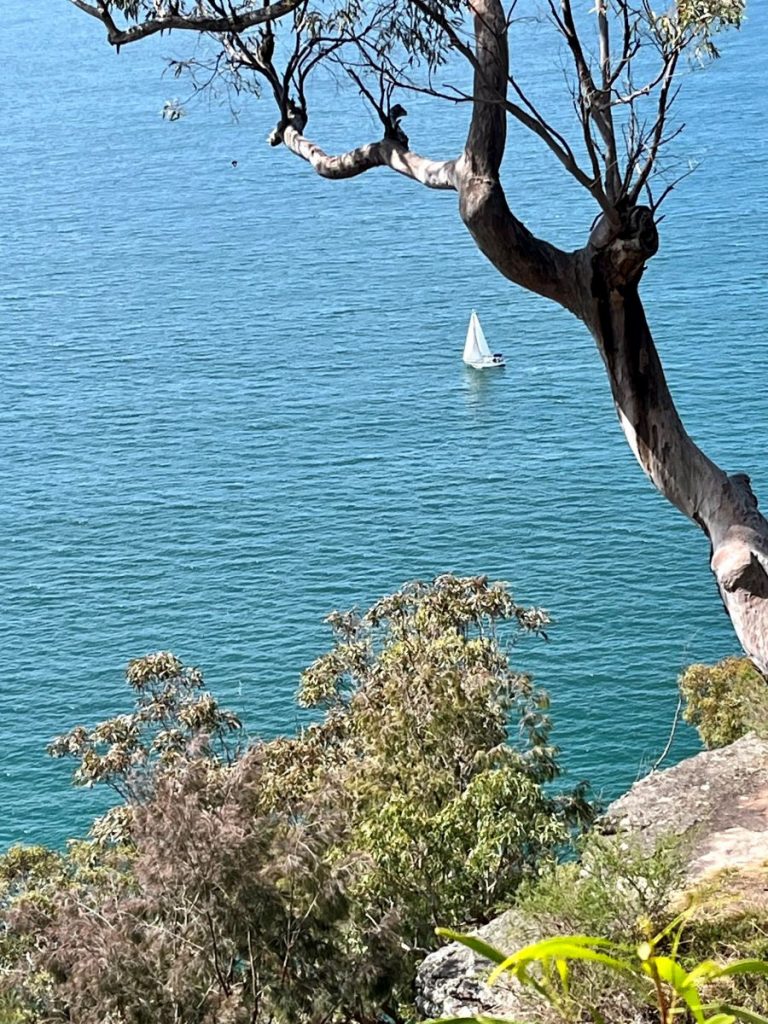
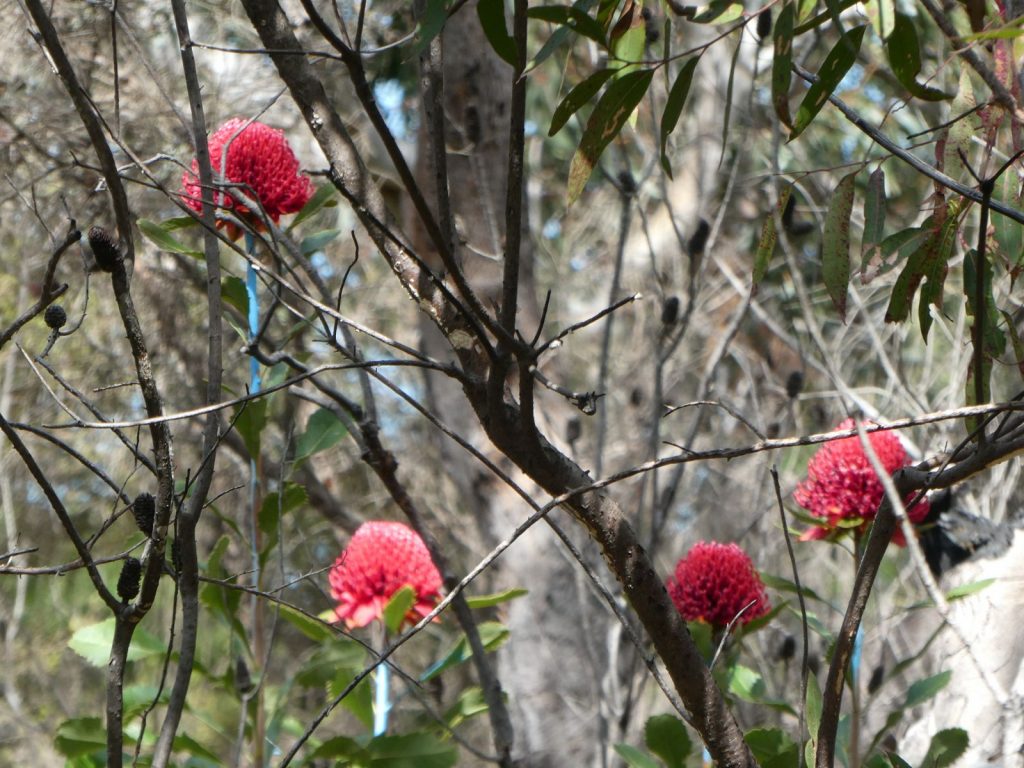
Leaving the West Head area, there was a great display of many Waratahs that could be seen from the bus. We had also been spotting them on Day 1 in the Royal National Park. A good year for Waratahs! Driving independently, Merle was able to ease over and try to zoom onto some.
Ku-ring-gai Wildflower Gardens
We next visited the Ku-ring-gai Wildflower Gardens at St Ives. Here, members of North Shore APS and Ku-ring-gai Council staff greeted us and we were treated to a delicious afternoon tea and even music provided by Mark Schuster, Bushfire Technical Officer with Ku-ring-gai Council.
Walks around the Gardens followed, visiting the main attractions there – fern house, Knoll Garden, bush tracks, the Visitors Centre and APS North Shore’s Plant Propagating Shadehouse.
Another full and interesting day.
Day 5 Sydney Harbour National Park and nearby areas
Today we visited florally interesting places on the Northern Beaches where members of the local APS Group guided us on walks, mostly within the Sydney Harbour National Park.
Dobroyd Head
Dobroyd Head was the first stop. An easy circular walk took us past a large variety of heath flowers and gave wonderful views across the water to South, Middle and North Heads.


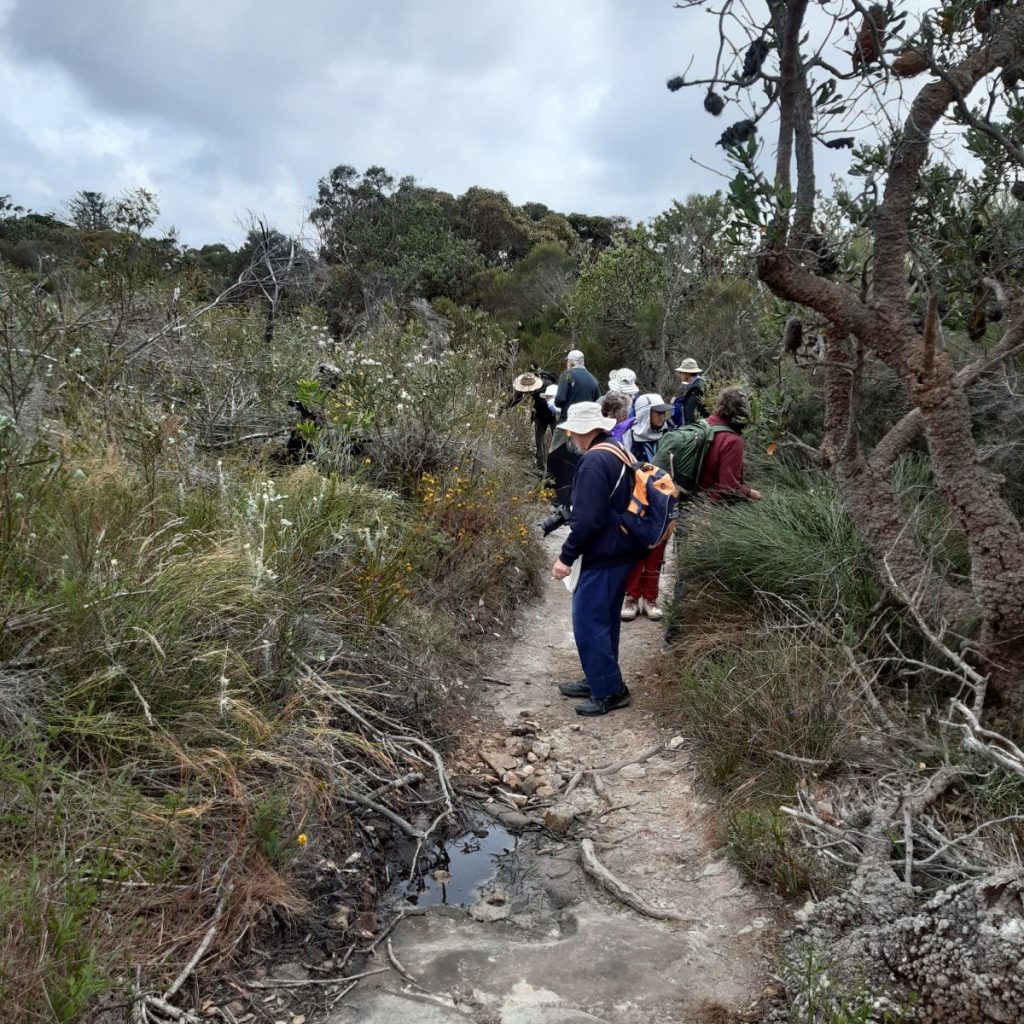
North Head
Photo at North Head are Barry’s and Chris’s.
East Coast Banksia Scrub
At North Head we walked through quite different East Coast Banksia Scrub and saw a lot of small birds feasting on the native flowers. Our route took us through the Third Cemetery, a very special place where poignant worn headstones told sad stories of amongst others, young men cut down in their prime by Spanish Flu picked up overseas before returning home at the end of World War 1 only to succumb at the nearby Quarantine Station. The colourful, informal, prolific array of flowering native plants inspired one of our tour guests to remark that all cemeteries should be like this.
Hanging Swamp
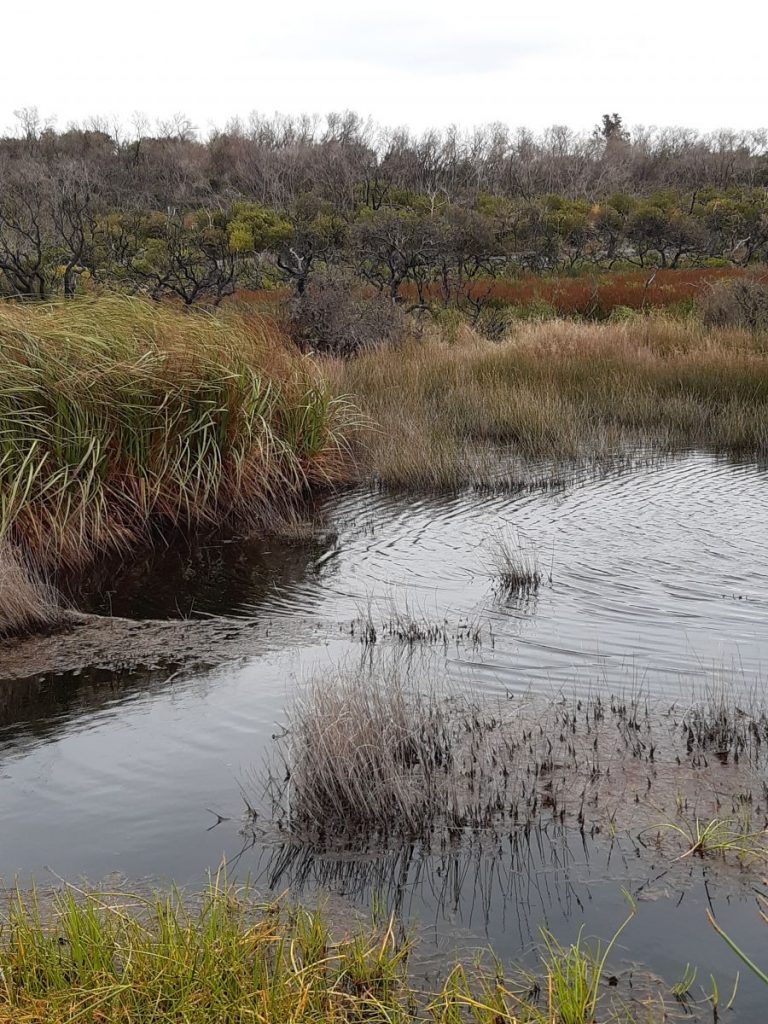
After lunch, we walked to the Hanging Swamp, which, as would be expected had lots of water following the months of rain. The Inky tannin-stained water made an interesting backdrop to the green of the water tolerant plants that we saw. (Barry’s Callistemon photo)
Barry found North Head to be a special aspect of the tour. There were several somewhat unique features about the North Head. What a variety in such a small area.
It is hard to think of another location that has sand over sandstone on an elevated headland that is exposed to sea breezes and strong winds. Add to this the surprise of seeing a perched wetland over what is normally considered to be a porous substrate, but it shows how over time accumulated vegetable matter can form a natural pond seal.
Within a relatively small area there was such a variety of plants, especially heath to swamp species. Flannel Flowers, Banksias, Acacias, a Fivecorner, Woody Pear and Sedges. Even a Callistemon citrinus growing almost in water.
We were also able to see vegetation recovery after a severe fire.
In addition to those natural features there were some social history reminders of earlier human occupation as shown by defence and quarantine station remnants. What a wonderful cemetery which is now a beautiful wildflower garden.
While the group enjoyed these wonderful places Merle and Jane March who co-ordinated Northern Beaches participation, had their own jaunt along the accessible Memorial Path. There were many species in flower and the signs of regeneration after the severe fire of a couple of years ago. Unfortunately the dull day did not provide a sparkling harbour as the backdrop
Chris was also particularly impressed with the perched lake.
Stony Range Regional Botanic Garden
The last visit for the day and indeed for the tour, was to Stony Range Regional Botanic Garden at Dee Why. The palms and Rock orchids growing under the canopy of trees make this place a rainforesty, peaceful haven to stroll around. Luckily the Sydney traffic co-operated in not shattering our relaxed state too much as we made our way to the drop off places in the city and the tour came to an end with a drop-off of people at Central Station and the Airport.
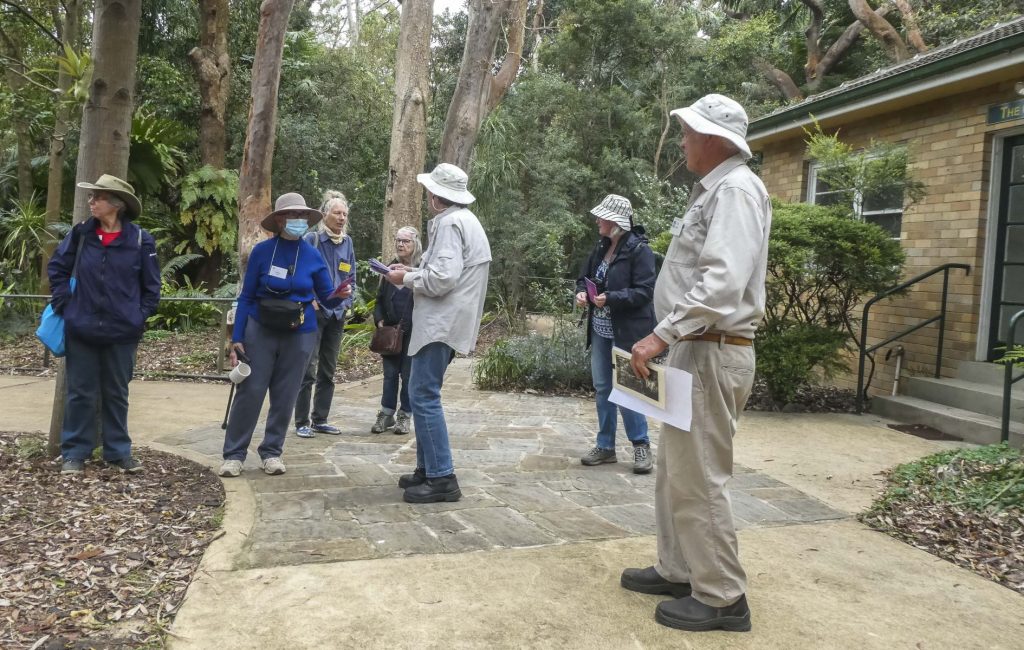
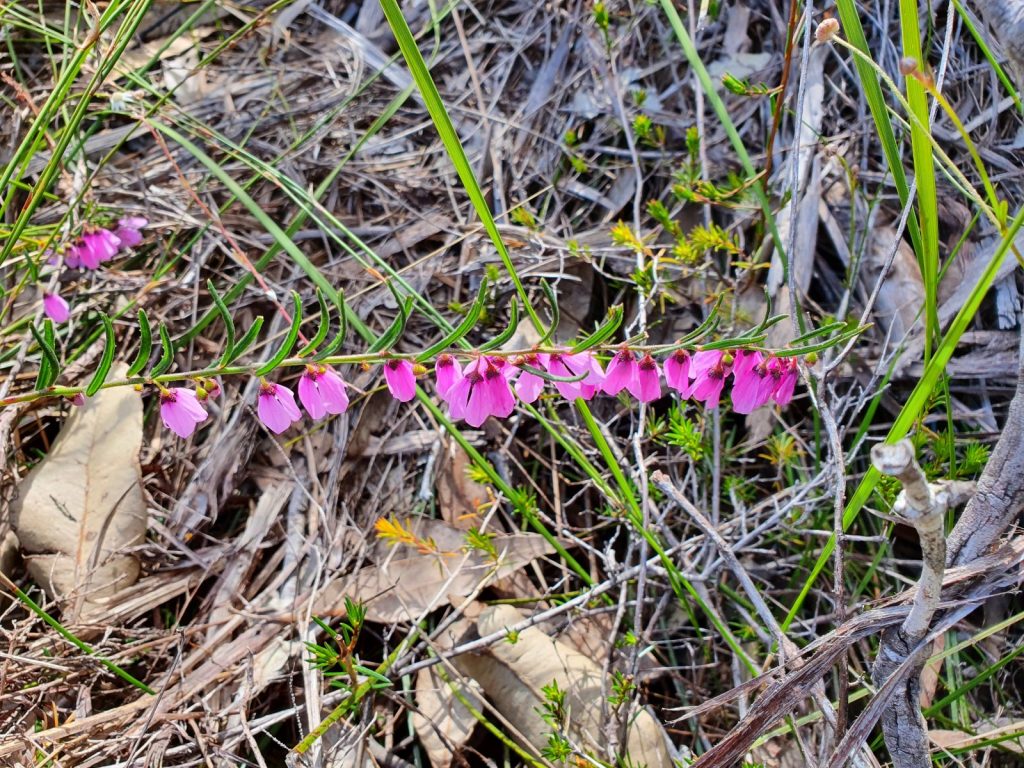
How was the tour received?
Participants summed up the experience as follows:
It was fabulous. Well planned, interesting and nice company as we had adventures each day and returned to our comfortable hotels at night. Lynne
In reflection it is difficult to select a highlight from this wonderful tour as each location had its own special features. Actually, it was that variety which made the whole tour so interesting, especially those of us who have had previous visits to the Sydney flora. This experience was so much better by having local guides who were able to introduce us to those special places and then share their knowledge and passions. Barry
Thanks for a great time seeing the wonderful array of flowers right on your doorstep! I am truly jealous of the amount of remnant bush almost in the heart of Sydney. Enough to make me question living here! Don’t ever envy WA when you have so much diversity and beauty in your wildflowers. It was great to spend the time with like minded Australian plant obsessives, Chris
Sue’s comments
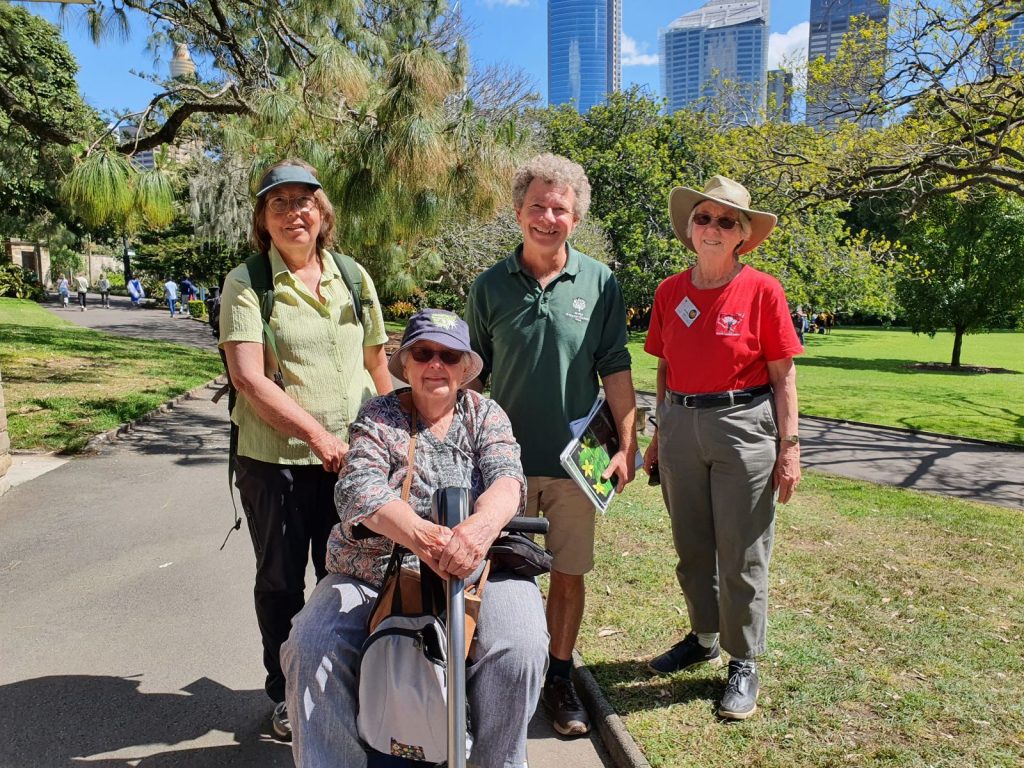
There are many people to thank for making the Surprising Sydney Flora Tour the success it was. Some have been mentioned already, but for the sake of brevity not all could be.
Merle Thompson planned the Tour, from location selection to endless communication with many- hotels, tour-guides, prospective tour participants – you name it! Sue researched and recce’d destinations and hopefully managed to impart the findings to the group in a mostly interesting way (and didn’t lose anyone!). Wendy also did recce’s and spent many, many hours researching the plants we encountered, identified them for people on site and created great plant lists for us to use. Michael, our driver, got us safely to our destinations and was a great support with tea breaks and in many other ways went beyond the call of duty. Members of the Parra Hills, Northern Beaches and North Shore APS Groups contributed with their excellent walk leading and commentary. Ian Cox for hosting us at his lovely house and garden and the staff of the Sydney Botanic Gardens for their time and expertise which made our visit there so interesting. The tour participants were a great bunch of people and we loved meeting them and that they enjoyed the tour.
